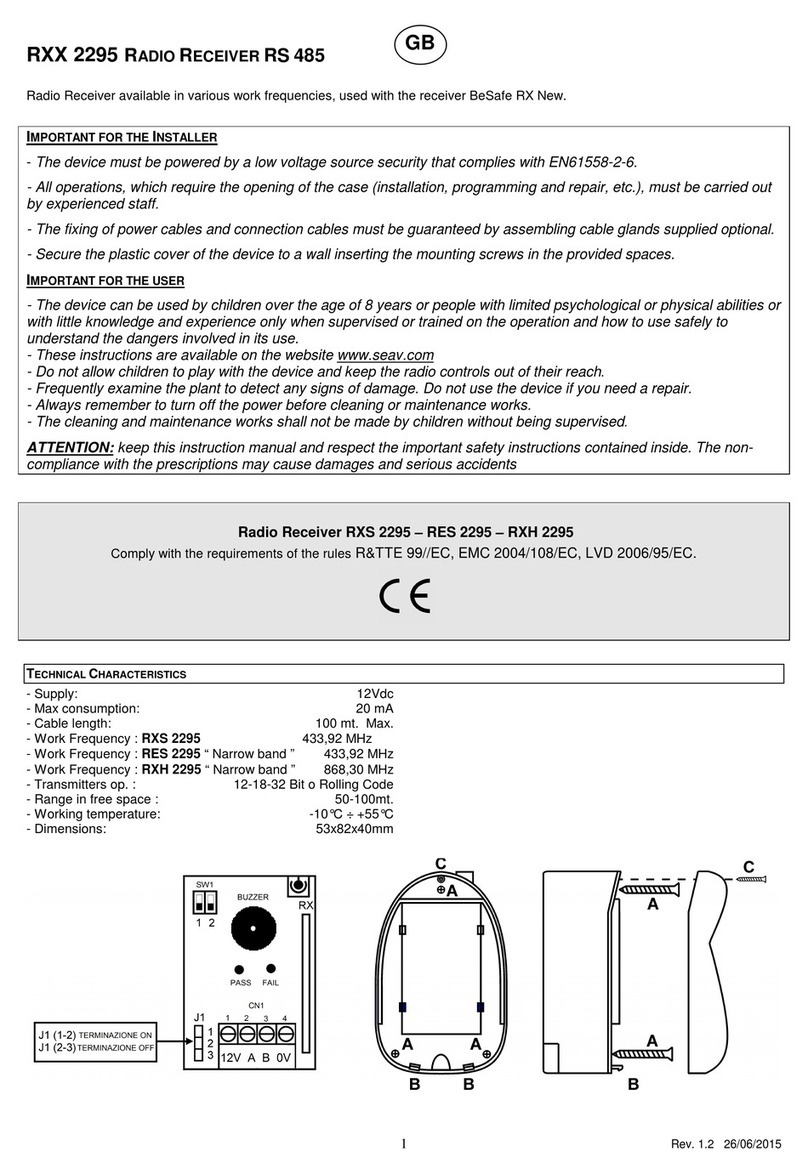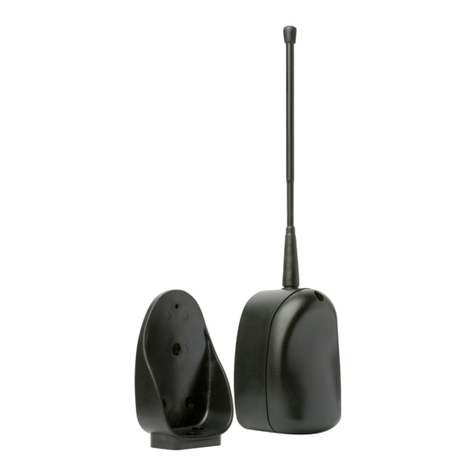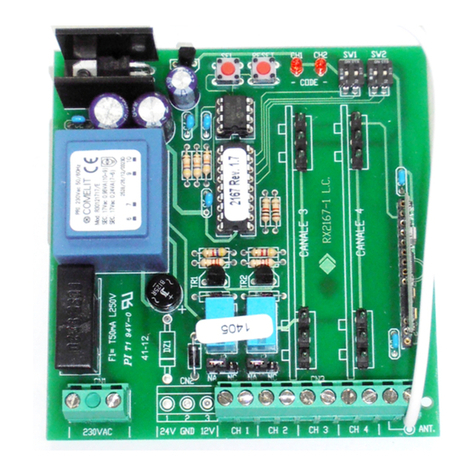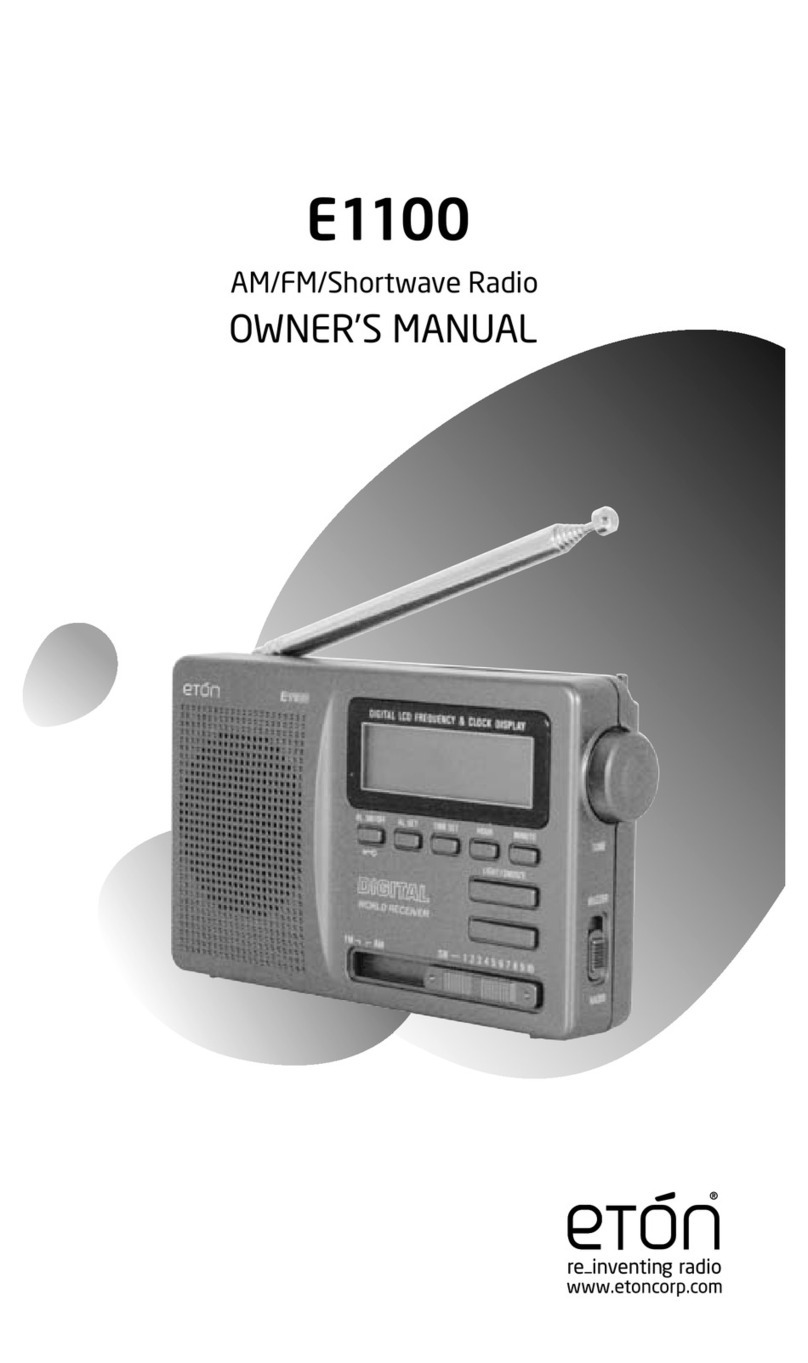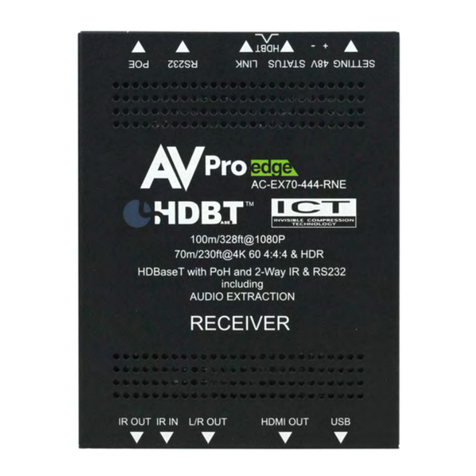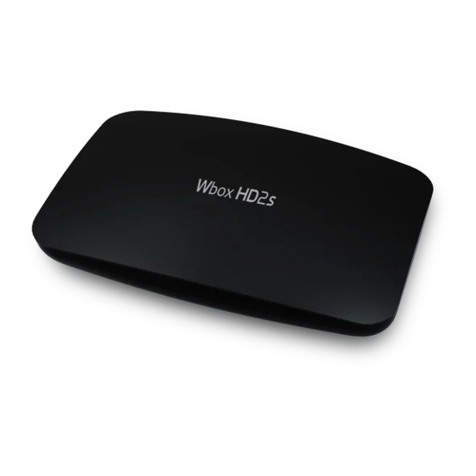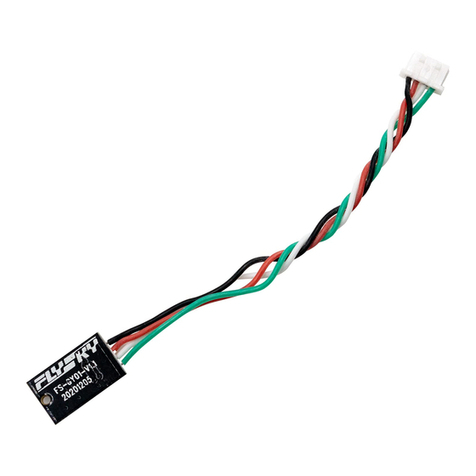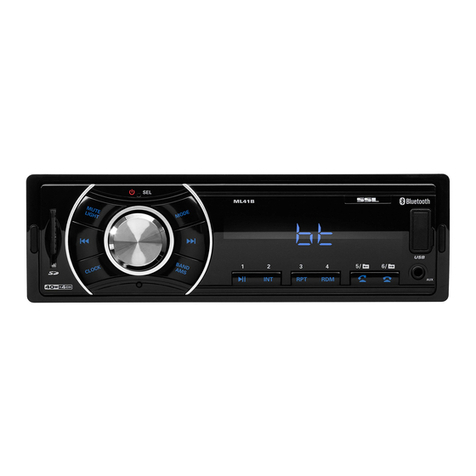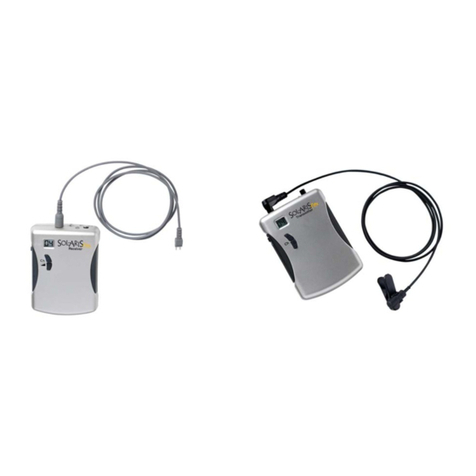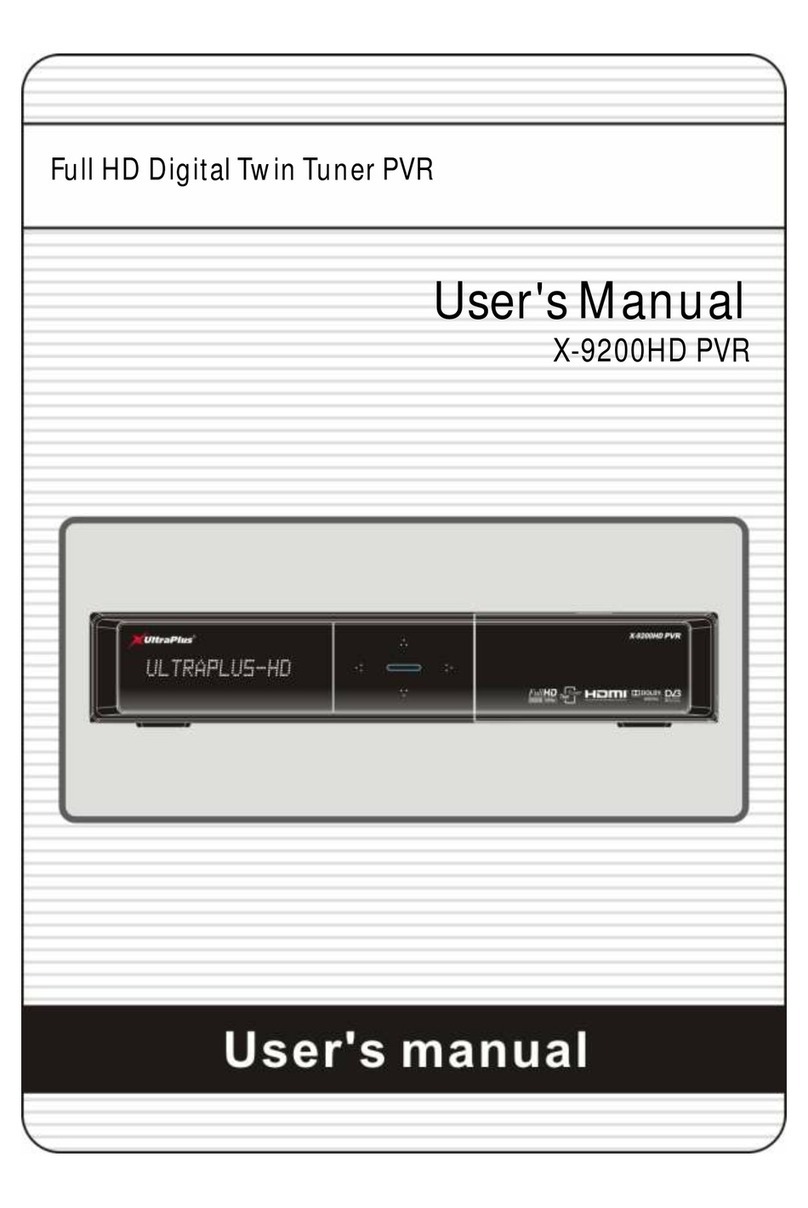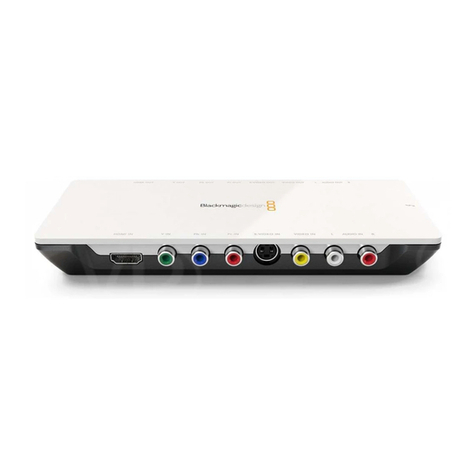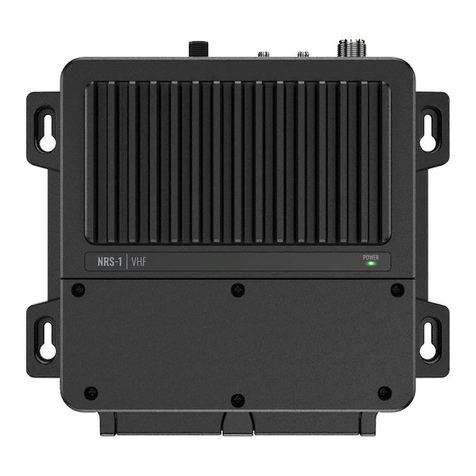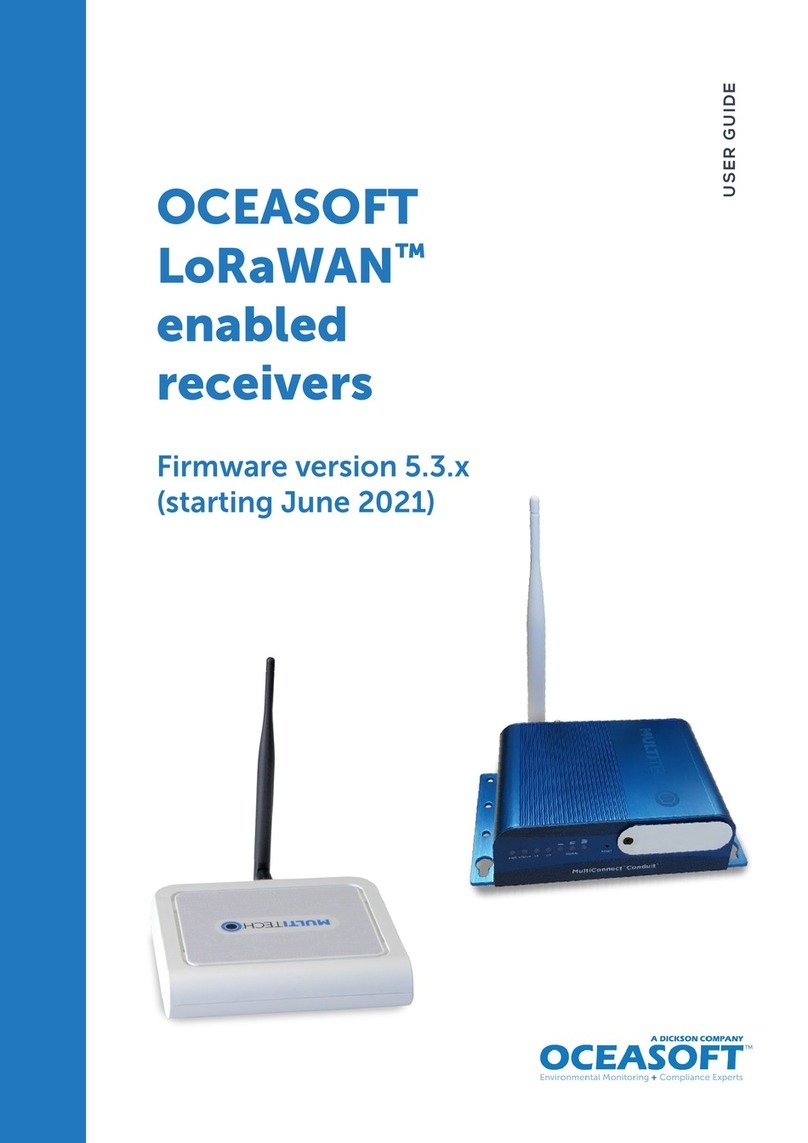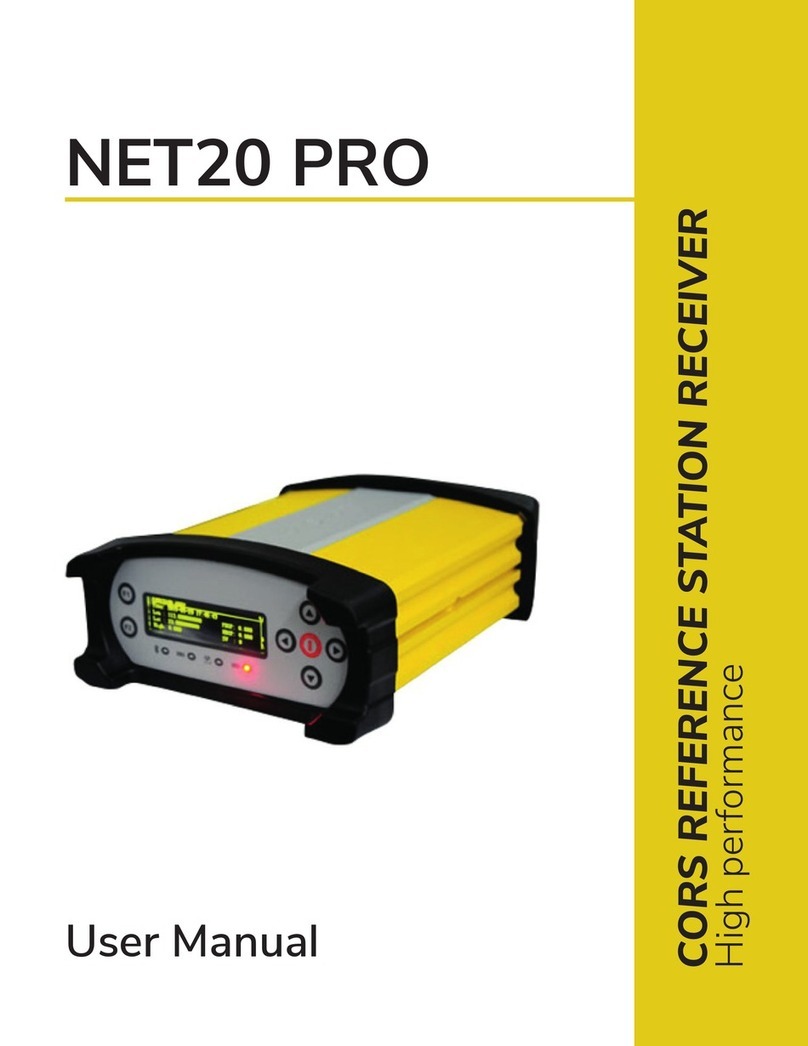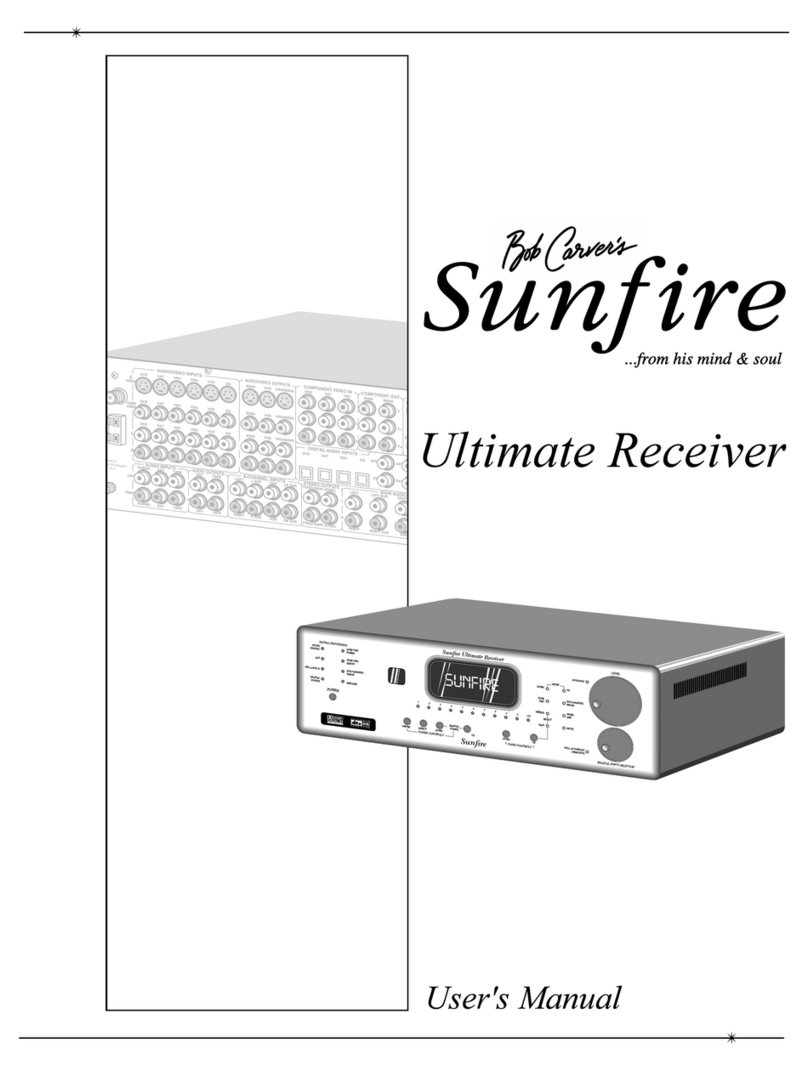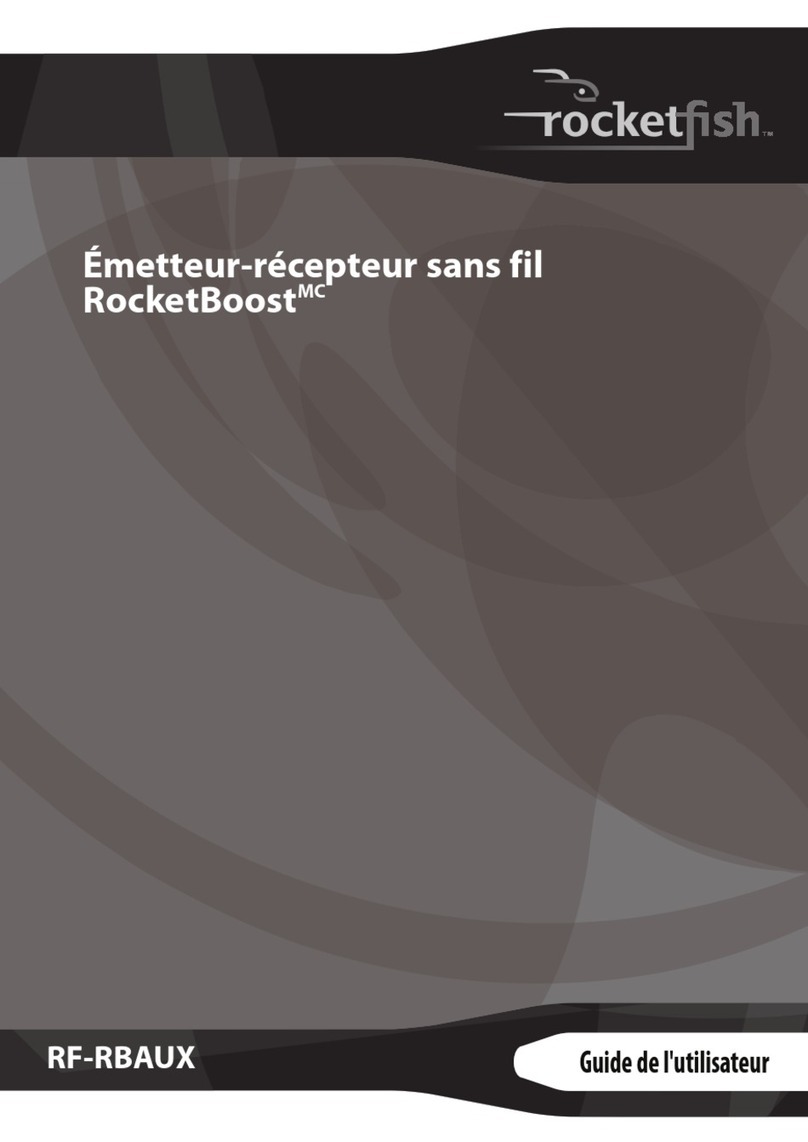Seav RXX 2322 230V User manual

Dual Channel Receiver RXX 2322 230V
DUAL CHANNEL RECEIVER
RXX 2322 230V
The miniature RXX 2322 230V dual channel radio receiver al-
lows remote control activation of electric and electronic devices
when coupled with one or more transmitters.
- RES 2322 230V : Narrow band ( up to 66 Bit ) 433,92 MHz
- RXH 2322 230V : Narrow band ( up to 66 Bit ) 868,30 MHz
IMPORTANT FOR THE USER
- The device can be used by children over 8 years of
age and persons with reduced physical or psychologic-
al abilities or with little knowledge and experience only
if supervised or educated in its operation and safe use,
in order to also understand the dangers involved in its
use.
- these instructions are also available at the website
www.seav.it
- Do not allow children to play with the device and keep
the remote controls out of their reach.
- Frequently examine the system to detect any signs of
damage. Do not use the device if it is in need of repair
work.
-Always remember to disconnect the power supply be-
fore carrying out any cleaning or maintenance.
- Cleaning and maintenance must not be carried out by
unsupervised children
- ATTENTION: keep this instruction manual safe and
observe the important safety requirements contained
herein. Failure to comply with the requirements may
cause damage and serious accidents.
IMPORTANT FOR THE INSTALLER
1)Check that the location where the installation is
located enables compliance with operating temperature
limits specified for the device.
2)Once installation is finished, it is recommended that
all necessary checks be performed (appropriate
programming of the control panel and correct
installation of safety devices) to ensure that compliant
installation has been performed.
3)Fix the receiver to a wall, using the relevant support
which is fitted to the casing, in such a way as to leave
said support facing downwards and insert the fixing
screws in the special holes.
4)The receiver does not have any type of isolating
device for the 230 Vac line. It is therefore the
responsibility of the installer to set up an isolating
device inside the system. It is necessary to install an
omnipolar switch, surge category III. It must be
positioned to provide protection from accidental
closing, pursuant to point 5.2.9 of EN 12453.
1)For proper functioning of the radio receiver, if using
one or more receivers, the installation at a minimum
distance of at least 3 metres one from the other is
recommended.
13) Furthermore, care is required when drilling holes in
the outside casing where connecting and power supply
cables will pass, and when assembling the cable
glands, so that everything is installed so as to maintain
the panel's IP protection characteristics.
Radio Receivers
RES 2322 230V – RXH 2322 230V
comply with the specifications of the Directives:
RED 2014/53/EU, EMC 2014/30/EU, LVD 2014/35/EU.
The full text regarding the EU Declaration of Conformity
is available from the following Internet address:
http://www.seav.it
TECHNICAL DATA
- Work frequency: see model
- Power supply: 230VAC
- Max. consumption: 5W
- Op. transmitters: Fixed code 12-18-32 Bit
Rolling Code 66 Bit
- TX codes that can be memorised (CH1 + CH2) : 250 Max
- Control relay: 230VAC 5A
- Working temperature: -10÷55°C
- Board dimensions : 99x50x28mm
- Container : ABS V-0
- Protection rating : IP 44 for internal use
CN1 TERMINAL BOARD CONNECTIONS
1: Power supply 230 VAC
2: Power supply 230 VAC
CN2 TERMINAL BOARD CONNECTIONS
1: “Normally open” contact output CH1
2: “Normally open” contact output CH1
3: “Normally open” contact output CH2
4: “Normally open” contact output CH2
1Rev. 1.0 13/02/2018
GB


RICEVITORE BICANALE
RXX 2322 230V
Il ricevitore miniatura bicanale radio RXX 2322 230V, consente l’attuazione
di comandi a distanza di apparecchiature elettriche ed elettroniche in abbi-
namento a uno o più trasmettitori.
RES 2322 230V : Narrow band ( up to 66 Bit ) 433,92 MHz
RXH 2322 230V : Narrow band ( up to 66 Bit ) 868,30 MHz
Importante per l’utente
-
Il dispositivo può essere utilizzato da
bambini di età superiore a 8 anni o da
persone con ridotte capacità psico-fi-
siche o con poca conoscenza ed espe-
rienza solamente se supervisionati o
istruiti sul funzionamento e le modalità
di utilizzo in maniera sicura per capire
anche i pericoli coinvolti nel suo utilizzo.
- queste istruzioni sono disponibili anche
sul sito www.seav.it
- Non consentire ai bambini di giocare
con il dispositivo e tenere lontano dalla
loro portata i radiocomandi.
- Esaminare frequentemente l’impianto
per rilevare eventuali segni di danneg-
giamento. Non utilizzare il dispositivo
se è necessario un intervento di ripara-
zione.
- Ricordarsi sempre di togliere l’alimen-
tazione prima di effettuare operazioni
di pulizia o manutenzione.
- Le operazioni di pulizia e manutenzione
non devono essere eseguite da bambini
senza essere supervisionati.
attenzIone:
conservare questo manuale
d’istruzioni e rispettare le importanti pre-
scrizioni di sicurezza in esso contenute. Il
non rispetto delle prescrizioni potrebbe
provocare danni e gravi incidenti.
Importante per l’Installatore
- Controllare che la locazione in cui è si-
I
3

4
tuata l’installazione consenta il rispetto
dei limiti di temperatura di esercizio in-
dicata per il dispositivo.
- Si consiglia, terminata l’installazione,
di eseguire tutti i controlli necessari
(programmazione opportuna della cen-
trale e corretta installazione dei dispo-
sitivi di sicurezza) per assicurarsi di aver
eseguito un’installazione conforme.
- Fissare la ricevente ad una parete, ser-
vendosi, per il montaggio, dell’apposito
supporto di cui è dotato l’involucro, in
modo tale da lasciare tale supporto
verso il basso ed inserire delle viti di
fissaggio negli appositi spazi.
- La ricevente non presenta nessun tipo
di dispositivo di sezionamento della
linea elettrica 230 Vac, sarà quindi
cura dell’installatore prevedere nell’im-
pianto un dispositivo di sezionamento.
E’ necessario installare un interruttore
omnipolare con categoria III di sovra-
tensione. Esso deve essere posizionato
in modo da essere protetto contro le
richiusure accidentali secondo quanto
previsto al punto 5.2.9 della EN 12453.
- Per un corretto funzionamento della
parte radio ricevente, in caso di utilizzo
di due o più riceventi, si consiglia l’in-
stallazione ad una distanza di almeno 3
metri l’una dall’altra.
- Fare attenzione inoltre, in fase di
foratura dell’ involucro esterno per
far passare cavi di alimentazione e
di colle-gamento, e di assemblaggio
dei pressacavi, ad installare il tutto
in modo da mantenere il più possibile
inalterate le caratteristiche di grado
IP della scatola.

5
Il testo completo della dichiarazione di conformità UE è disponibile al seguente indirizzo
Internet:
http://www.seav.it
CARATTERISTICHE TECNICHE:
- Frequenza di lavoro : vedi modello
- Alimentazione : 230VAC
- Consumo max : 5W
- Trasmettitori op. : Fixed code 12-18-32 Bit
Rolling Code 66 Bit
- Codici TX memorizzabili (CH1 + CH2) : 250 Max
- Relè di comando : 230VAC 5A
- Temperatura di esercizio : -10÷55°C
- Dimensioni scheda : 99x50x28mm
- Contenitore : ABS V-0
- Grado di protezione : IP 44 per uso interno
DUAL CHANNEL RECEIVER
RXX 2322 230V
The miniature RXX 2322 230V dual channel radio receiver al-
lows remote control activation of electric and electronic devices
when coupled with one or more transmitters.
- RES 2322 230V : Narrow band ( up to 66 Bit ) 433,92 MHz
- RXH 2322 230V : Narrow band ( up to 66 Bit ) 868,30 MHz
IMPORTANT FOR THE USER
- The device can be used by children over 8 years of
age and persons with reduced physical or psychologic-
al abilities or with little knowledge and experience only
if supervised or educated in its operation and safe use,
in order to also understand the dangers involved in its
use.
- these instructions are also available at the website
www.seav.it
- Do not allow children to play with the device and keep
the remote controls out of their reach.
- Frequently examine the system to detect any signs of
damage. Do not use the device if it is in need of repair
work.
-Always remember to disconnect the power supply be-
fore carrying out any cleaning or maintenance.
- Cleaning and maintenance must not be carried out by
unsupervised children
- ATTENTION: keep this instruction manual safe and
observe the important safety requirements contained
herein. Failure to comply with the requirements may
cause damage and serious accidents.
IMPORTANT FOR THE INSTALLER
1)Check that the location where the installation is
located enables compliance with operating temperature
limits specified for the device.
2)Once installation is finished, it is recommended that
all necessary checks be performed (appropriate
programming of the control panel and correct
installation of safety devices) to ensure that compliant
installation has been performed.
3)Fix the receiver to a wall, using the relevant support
which is fitted to the casing, in such a way as to leave
said support facing downwards and insert the fixing
screws in the special holes.
4)The receiver does not have any type of isolating
device for the 230 Vac line. It is therefore the
responsibility of the installer to set up an isolating
device inside the system. It is necessary to install an
omnipolar switch, surge category III. It must be
positioned to provide protection from accidental
closing, pursuant to point 5.2.9 of EN 12453.
1)For proper functioning of the radio receiver, if using
one or more receivers, the installation at a minimum
distance of at least 3 metres one from the other is
recommended.
13) Furthermore, care is required when drilling holes in
the outside casing where connecting and power supply
cables will pass, and when assembling the cable
glands, so that everything is installed so as to maintain
the panel's IP protection characteristics.
Radio Receivers
RES 2322 230V – RXH 2322 230V
comply with the specifications of the Directives:
RED 2014/53/EU, EMC 2014/30/EU, LVD 2014/35/EU.
The full text regarding the EU Declaration of Conformity
is available from the following Internet address:
http://www.seav.it
TECHNICAL DATA
- Work frequency: see model
- Power supply: 230VAC
- Max. consumption: 5W
- Op. transmitters: Fixed code 12-18-32 Bit
Rolling Code 66 Bit
- TX codes that can be memorised (CH1 + CH2) : 250 Max
- Control relay: 230VAC 5A
- Working temperature: -10÷55°C
- Board dimensions : 99x50x28mm
- Container : ABS V-0
- Protection rating : IP 44 for internal use
CN1 TERMINAL BOARD CONNECTIONS
1: Power supply 230 VAC
2: Power supply 230 VAC
CN2 TERMINAL BOARD CONNECTIONS
1: “Normally open” contact output CH1
2: “Normally open” contact output CH1
3: “Normally open” contact output CH2
4: “Normally open” contact output CH2
1Rev. 1.0 13/02/2018
GB
COLLEGAMENTI DELLA MORSETTIERIA:
CN1:
1 : Alimentazione 230 VAC
2 : Alimentazione 230 VAC
COLLEGAMENTI DELLA MORSETTIERIA:
CN2:
1 : Uscita contatto “ normalmente aperto ” CH1
2 : Uscita contatto “ normalmente aperto ” CH1
3 : Uscita contatto “ normalmente aperto ” CH2
4 : Uscita contatto “ normalmente aperto ” CH2
INSTALLAZIONE DEL RICEVITORE
Per ottenere un funzionamento ottimale fra trasmettitore e ricevitore, è bene
scegliere con attenzione il luogo di installazione. La portata non è solamente
legata alle caratteristiche tecniche del dispositivo, ma varia anche dalle con-
dizioni radioelettriche del luogo. La ricevente è dotata di antenna accordata.
Non è possibile l’installazione di due ricevitori che non rispettino almeno una
distanza di 5 metri fra di loro.
MODALITÀ DI FUNZIONAMENTO CH1 E CH2
La ricevente è in grado di gestire i due canali in modo separato ed inoltre
permette di avere anche diverse modalità di funzionamente:
Canale CH1: solo funzionamento monostabile con possibilità di attivazione
della Programmazione a Distanza.
Canale CH2: tramite la selezione dello Switch SW1, è possibile selezionare
le seguenti modalità di funzionamento per il canale CH2 ( in modalità Pgm a
distanza il funzionamento è monostabile).
INSTALLAZIONE DEL RICEVITORE
Per ottenere un funzionamento ottimale fra trasmettitore e rice-
vitore, è bene scegliere con attenzione il luogo di installazione.
La portata non è solamente legata alle caratteristiche tecniche
del dispositivo, ma varia anche dalle condizioni radioelettriche
del luogo. La ricevente è dotata di antenna accordata.
Non è possibile l'installazione di due ricevitori che non rispettino
almeno una distanza di 5 metri fra di loro.
MODALITÀ DI FUNZIONAMENTO CH1 E CH2
La ricevente è in grado di gestire i due canali in modo separato
ed inoltre permette di avere anche diverse modalità di funziona-
mente:
Canale CH1: solo funzionamento monostabile con possibili-
tà di attivazione della Programmazione a Distanza.
Canale CH2: tramite la selezione dello Switch SW1, è
possibile selezionare le seguenti modalità di funziona-
mento per il canale CH2 ( in modalità Pgm a distanza il
funzionamento è monostabile).
MONOSTABILE PGM A DISTANZA TEMP. 120 SEC BISTABILE
( CH1 E CH2)
MODALITÀ DI PROGRAMMAZIONE
La programmazione dei Radiocomandi da associare, è del tipo
ad Autoapprendimento e viene eseguita con l’antenna non
collegata nel seguente modo: premere una volta il tasto SEL, il
Led CODE CH1 inizierà a lampeggiare allo stesso tempo invia-
re il codice prescelto con il radiocomando, ad una distanza di
qualche metro, nel momento in cui il Led resterà acceso perma-
nentemente, la programmazione nel canale CH1 sarà comple-
tata. Per memorizzare un codice di un radiocomando nel canale
CH2 eseguire la stessa procedura sopra descritta premendo il
tasto SEL due volte.
È possibile ripetere la procedura di memorizzazione fino ad un
max. di 500 codici complessivi, quando la memoria disponibile
sarà esaurita, ripetendo l'operazione di programmazione, i Led
CODE CH1 e CODE CH2 , inizierànno a lampeggiare molto ve-
locemente segnalando che non sono possibili ulteriori memoriz-
zazioni.
MODALITÀ DI PROGRAMMAZIONE A DISTANZA
La programmazione dei Radiocomandi a distanza si ottiene se-
lezionando il Dip Switch SW1 in modalità ‘Pgm a distanza’, in
questo modo la ricevente consente la programmazione del co-
dice di trasmissione, senza intervenire direttamente sul tasto
SEL.
La programmazione del codice di trasmissione a distanza, si
esegue nel seguente modo: inviare in modo continuo per un
tempo maggiore a 10 secondi il codice di un radiocomando in
precedenza memorizzato in un canale, allo stesso tempo la ri-
cevente entra in modalità di programmazione, come di seguito
descritto, per ciascuno dei due canali.
REGOLA DEL PRIMO RADIOCOMANDO MEMORIZZATO
Nella programmazione dei radiocomandi vige la seguente rego-
la: se il primo radiocomando ad essere memorizzato è un radio-
comando di tipo Rolling Code il ricevitore accetterà poi solo ra-
diocomandi Rolling Code, garantendo così una maggiore sicu-
rezza antintrusione; se invece il primo radiocomando ad essere
memorizzato è un radiocomando a codice fisso il ricevitore ac-
cetterà poi sia radiocomandi a codice fisso che radiocomandi
Rolling Code.
RESET
Nel caso sia opportuno ripristinare la ricevente alla configura-
zione di fabbrica (cioè nessun codice memorizzato), premere il
tasto SEL in modo continuo per 5 secondi, i Led CODE CH1 e
CODE CH2 emetterànno tre brevi lampeggi e si spegnerànno.
1Rev. 1.0 13/02/2018
Ricevitori Radio
RES 2322 230V – RXH 2322 230V
sono conformi alle specifiche delle Direttive
RED 2014/53/EU, EMC 2014/30/EU, LVD 2014/35/EU.

6
MODALITÀ DI PROGRAMMAZIONE
La programmazione dei Radiocomandi da associare, è del tipo ad Autoap-
prendimento e viene eseguita con l’antenna non collegata nel seguente
modo: premere una volta il tasto SEL, il Led CODE CH1 inizierà a lampeggiare
allo stesso tempo inviare il codice prescelto con il radiocomando, ad una
distanza di qualche metro, nel momento in cui il Led resterà acceso perma-
nentemente, la programmazione nel canale CH1 sarà completata. Per memo-
rizzare un codice di un radiocomando nel canale CH2 eseguire la stessa
procedura sopra descritta premendo il tasto SEL due volte.
È possibile ripetere la procedura di memorizzazione fino ad un max. di 500
codici complessivi, quando la memoria disponibile sarà esaurita, ripetendo
l’operazione di programmazione, i Led CODE CH1 e CODE CH2 , inizierànno a
lampeggiare molto velocemente segnalando che non sono possibili ulteriori
memorizzazioni.
MODALITÀ DI PROGRAMMAZIONE A DISTANZA
La programmazione dei Radiocomandi a distanza si ottiene selezionando il
Dip Switch SW1 in modalità ‘Pgm a distanza’, in questo modo la ricevente
consente la programmazione del codice di trasmissione, senza intervenire
direttamente sul tasto SEL.
La programmazione del codice di trasmissione a distanza, si esegue nel
seguente modo: inviare in modo continuo per un tempo maggiore a 10
secondi il codice di un radiocomando in precedenza memorizzato in un
canale, allo stesso tempo la ricevente entra in modalità di programmazione,
come di seguito descritto, per ciascuno dei due canali.
REGOLA DEL PRIMO RADIOCOMANDO MEMORIZZATO
Nella programmazione dei radiocomandi vige la seguente regola: se il primo
radiocomando ad essere memorizzato è un radiocomando di tipo Rolling
Code il ricevitore accetterà poi solo radiocomandi Rolling Code, garantendo
così una maggiore sicurezza antintrusione; se invece il primo radiocomando
ad essere memorizzato è un radiocomando a codice fisso il ricevitore accet-
terà poi sia radiocomandi a codice fisso che radiocomandi Rolling Code.
RESET
Nel caso sia opportuno ripristinare la ricevente alla configurazione di
fabbrica (cioè nessun codice memorizzato), premere il tasto SEL in modo
continuo per 5 secondi, i Led CODE CH1 e CODE CH2 emetterànno tre brevi
lampeggi e si spegneranno.
Rev. 1.0 13/02/2018

DUAL CHANNEL RECEIVER
RXX 2322 230V
The miniature RXX 2322 230V dual channel radio receiver allows remote
control activation of electric and electronic devices when coupled with one
or more transmitters.
RES 2322 230V : Narrow band ( up to 66 Bit ) 433,92 MHz
RXH 2322 230V : Narrow band ( up to 66 Bit ) 868,30 MHz
Important for the user
-
The device can be used by children over
8 years of age and persons with reduced
physical or psychological abilities or
with little knowledge and experience
only if supervised or educated in its op-
eration and safe use, in order to also un-
derstand the dangers involved in its use.
- these instructions are also available at
the website www.seav.it
- Do not allow children to play with the
device and keep the remote controls out
of their reach.
- Frequently examine the system to de-
tect any signs of damage. Do not use
the device if it is in need of repair work.
- Always remember to disconnect the
power supply before carrying out any
cleaning or maintenance.
- Cleaning and maintenance must not be
carried out by unsupervised children.
attentIon:
keep this instruction manual
safe and observe the important safety re-
quirements contained herein. Failure to
comply with the requirements may cause
damage and serious accidents.
Important for the Installer
- Check that the location where the instal-
lation is located enables compliance with
operating temperature limits specified for
the device.
- Once installation is finished, it is rec-
GB
7

8
ommended that all necessary checks
be performed (appropriate program-
ming of the control panel and correct
installation of safety devices) to ensure
that compliant installation has been
performed.
- Fix the receiver to a wall, using the rele-
vant support which is fitted to the casing,
in such a way as to leave said support
facing downwards and insert the fixing
screws in the special holes.
- The receiver does not have any type of
isolating device for the 230 Vac line. It
is therefore the responsibility of the in-
staller to set up an isolating device inside
the system. It is necessary to install an
omnipolar switch, surge category III. It
must be positioned to provide protection
from accidental closing, pursuant to point
5.2.9 of EN 12453.
- For proper functioning of the radio re-
ceiver, if using one or more receivers, the
installation at a minimum distance of at
least 3 metres one from the other is rec-
ommended.
- Furthermore, care is required when drill-
ing holes in the outside casing where
connecting and power supply cables will
pass, and when assembling the cable
glands, so that everything is installed so
as to maintain the panel’s IP protection
characteristics.
The full text regarding the EU Declaration of Conformity is available from the following
Internet address:
http://www.seav.it
Radio Receivers
RES 2322 230V – RXH 2322 230V
comply with the specifications of the Directives:
RED 2014/53/EU, EMC 2014/30/EU, LVD 2014/35/EU.

9
TECHNICAL DATA:
- Work frequency : see model
- Power supply : 230VAC
- Max. consumption : 5W
- Op. transmitters : Fixed code 12-18-32 Bit
Rolling Code 66 Bit
- TX codes that can be memorised (CH1 + CH2) : 250 Max
- Control relay : 230VAC 5A
- Working temperature : -10÷55°C
- Board dimensions : 99x50x28mm
- Container : ABS V-0
- Protection rating : IP 44 for internal use
DUAL CHANNEL RECEIVER
RXX 2322 230V
The miniature RXX 2322 230V dual channel radio receiver al-
lows remote control activation of electric and electronic devices
when coupled with one or more transmitters.
- RES 2322 230V : Narrow band ( up to 66 Bit ) 433,92 MHz
- RXH 2322 230V : Narrow band ( up to 66 Bit ) 868,30 MHz
IMPORTANT FOR THE USER
- The device can be used by children over 8 years of
age and persons with reduced physical or psychologic-
al abilities or with little knowledge and experience only
if supervised or educated in its operation and safe use,
in order to also understand the dangers involved in its
use.
- these instructions are also available at the website
www.seav.it
- Do not allow children to play with the device and keep
the remote controls out of their reach.
- Frequently examine the system to detect any signs of
damage. Do not use the device if it is in need of repair
work.
-Always remember to disconnect the power supply be-
fore carrying out any cleaning or maintenance.
- Cleaning and maintenance must not be carried out by
unsupervised children
- ATTENTION: keep this instruction manual safe and
observe the important safety requirements contained
herein. Failure to comply with the requirements may
cause damage and serious accidents.
IMPORTANT FOR THE INSTALLER
1)Check that the location where the installation is
located enables compliance with operating temperature
limits specified for the device.
2)Once installation is finished, it is recommended that
all necessary checks be performed (appropriate
programming of the control panel and correct
installation of safety devices) to ensure that compliant
installation has been performed.
3)Fix the receiver to a wall, using the relevant support
which is fitted to the casing, in such a way as to leave
said support facing downwards and insert the fixing
screws in the special holes.
4)The receiver does not have any type of isolating
device for the 230 Vac line. It is therefore the
responsibility of the installer to set up an isolating
device inside the system. It is necessary to install an
omnipolar switch, surge category III. It must be
positioned to provide protection from accidental
closing, pursuant to point 5.2.9 of EN 12453.
1)For proper functioning of the radio receiver, if using
one or more receivers, the installation at a minimum
distance of at least 3 metres one from the other is
recommended.
13) Furthermore, care is required when drilling holes in
the outside casing where connecting and power supply
cables will pass, and when assembling the cable
glands, so that everything is installed so as to maintain
the panel's IP protection characteristics.
Radio Receivers
RES 2322 230V – RXH 2322 230V
comply with the specifications of the Directives:
RED 2014/53/EU, EMC 2014/30/EU, LVD 2014/35/EU.
The full text regarding the EU Declaration of Conformity
is available from the following Internet address:
http://www.seav.it
TECHNICAL DATA
- Work frequency: see model
- Power supply: 230VAC
- Max. consumption: 5W
- Op. transmitters: Fixed code 12-18-32 Bit
Rolling Code 66 Bit
- TX codes that can be memorised (CH1 + CH2) : 250 Max
- Control relay: 230VAC 5A
- Working temperature: -10÷55°C
- Board dimensions : 99x50x28mm
- Container : ABS V-0
- Protection rating : IP 44 for internal use
CN1 TERMINAL BOARD CONNECTIONS
1: Power supply 230 VAC
2: Power supply 230 VAC
CN2 TERMINAL BOARD CONNECTIONS
1: “Normally open” contact output CH1
2: “Normally open” contact output CH1
3: “Normally open” contact output CH2
4: “Normally open” contact output CH2
1Rev. 1.0 13/02/2018
GB
TERMINAL BOARD CONNECTIONS:
CN1:
1 : Power supply 230 VAC
2 : Power supply 230 VAC
TERMINAL BOARD CONNECTIONS:
CN2:
1 : “Normally open” contact output ” CH1
2 : “Normally open” contact output ” CH1
3 : “Normally open” contact output ” CH2
4 : “Normally open” contact output ” CH2
INSTALLATION OF THE RECEIVER
It is very important to choose the place of installation carefully in order for
the transmitter and the receiver to function well. Capacity is not only condi-
tioned by the technical features of the device, but also varies depending on
the radio-electric conditions of the site. The receiver has a tuned antenna.
There must be a distance of at least 5 metres between the two receivers if
installation is to be successful.
CH1 AND CH2 FUNCTIONING METHOD
The receiver can manage the two channels separately and also allows to
have different functioning modes:
Channel CH1: monostable functioning only with possibility of activation of
Long Distance Programming
Channel CH2: by selecting Switch SW1, it is possible to select the follow-
ing functioning modes for channel CH2 (in long distance functioning mode
it is monostable).
INSTALLATION OF THE RECEIVER
It is very important to choose the place of installation carefully in
order for the transmitter and the receiver to function well. Capa-
city is not only conditioned by the technical features of the
device, but also varies depending on the radio-electric condi-
tions of the site. The receiver has a tuned antenna.
There must be a distance of at least 5 metres between the two
receivers if installation is to be successful.
CH1 AND CH2 FUNCTIONING METHOD
The receiver can manage the two channels separately and also
allows to have different functioning modes:
Channel CH1: monostable functioning only with possibility of
activation of Long Distance Programming.
Channel CH2: by selecting Switch SW1, it is possible to
select the following functioning modes for channel CH2
(in long distance functioning mode it is monostable).
MONOSTABLE LONG DISTANCE PGM TEMP. 120 SEC B
ISTABLE
( CH1 AND CH2)
PROGRAMMING MODE
Programming of the Radio-controls to be associated is the Self-
learning type and is performed with the antenna not connec-
ted in the following way: press SEL once, the CODE CH1 LED
will start to flash and at the same time sends the pre-selected
code with the radio control to a distance of a few metres. When
the LED remains on, programming in the CH1 channel will be
completed. To memorise a radio control code in channel CH2,
perform the same procedure described above and pressing the
SEL key twice.
The memorisation procedure can be repeated up to a max. of
500 codes. When the memory is full by repeating the program-
ming operation, the CODE CH1 AND CODE CH2 LEDs will
start to flash very quickly, indicating that no more memorisa-
tions can take place.
LONG DISTANCE PROGRAMMING METHOD
The long distance programming of radio controls is obtained by
selecting Dip Switch SW1 in long distance [Pgm mode. In this
way the receiver allows programming of the transmission code,
without intervening directly on the SEL key.
The remote transmission code can be programmed as follows:
continuously send a radio control code, which was previously
memorised in a channel, for more than 10 seconds. At this
point, the receiver switches to programming mode, as de-
scribed below, for both channels.
RULE FOR THE FIRST RADIO CONTROL MEMORISED
The following rule applies when programming radio controls: if
the first radio control to be memorised is a Rolling Code type of
radio control, the receiver will then only accept Rolling Code ra-
dio controls, thus assuring increased intrusion detection safety.
If, however, the first radio control to be memorised is a radio
control with a fixed code, the receiver will then accept both ra-
dio controls with a fixed code and radio controls with a Rolling
Code.
RESET
If the receiver must be restored to factory configuration (i.e. no
code memorised), press the SEL key continuously for 5
seconds. The CODE CH1 and CODE CH2 LEDs will flash three
times quickly and then switch-off.
1Rev. 1.0 13/02/2018
PROGRAMMING MODE
Programming of the Radio-controls to be associated is the Self-learning type
and is performed with the antenna not connected in the following way:
press SEL once, the CODE CH1 LED will start to flash and at the same time
sends the pre-selected code with the radio control to a distance of a few
metres. When the LED remains on, programming in the CH1 channel will be

10
completed. To memorise a radio control code in channel CH2, perform the
same procedure described above and pressing the SEL key twice.
The memorisation procedure can be repeated up to a max. of 500 codes.
When the memory is full by repeating the programming operation, the CODE
CH1 AND CODE CH2 LEDs will start to flash very quickly, indicating that no
more memorisations can take place.
LONG DISTANCE PROGRAMMING METHOD
The long distance programming of radio controls is obtained by selecting
Dip Switch SW1 in long distance [Pgm mode. In this way the receiver al-
lows programming of the transmission code, without intervening directly
on the SEL key.
The remote transmission code can be programmed as follows: continuously
send a radio control code, which was previously memorised in a channel, for
more than 10 seconds. At this point, the receiver switches to programming
mode, as described below, for both channels.
RULE FOR THE FIRST RADIO CONTROL MEMORISED
The following rule applies when programming radio controls: if the first radio
control to be memorised is a Rolling Code type of radio control, the receiver
will then only accept Rolling Code radio controls, thus assuring increased
intrusion detection safety. If, however, the first radio control to be memorised
is a radio control with a fixed code, the receiver will then accept both radio
controls with a fixed code and radio controls with a Rolling Code.
RESET
If the receiver must be restored to factory configuration (i.e. no code memo-
rised), press the SEL key continuously for 5 seconds. The CODE CH1 and
CODE CH2 LEDs will flash three times quickly and then switch-off.
Rev. 1.0 13/02/2018

RÉCEPTEUR BICANAL
RXX 2322 230V
Le récepteur radio bicanal miniature RXX 2322 230V permet l’activation de
commandes à distance d’appareils électriques et électroniques combinés à
un ou plusieurs transmetteurs.
RES 2322 230V : Bande étroite (jusqu’à 66 Bits) 433,92 MHz
RXH 2322 230V : Bande étroite (jusqu’à 66 Bits) 868,30 MHz
InformatIons Importantes pour l’utIlIsateur
-
Le dispositif peut être utilisé par des
enfants âgés de plus de 8 ans et par
des personnes aux capacités psychiques
et physiques réduites ou ayant peu de
connaissances ou d’expérience, à condi-
tion qu’ils soient surveillés ou qu’ils aient
reçu des instructions relatives au fonc-
tionnement et aux modalités d’utilisation
en toute sécurité, afin de comprendre
aussi les dangers liés à l’utilisation du
dispositif.
- Ces instructions sont également dispo-
nibles sur le site www.seav.it
- Ne pas permettre aux enfants de jouer
avec le dispositif et garder les com-
mandes radio hors de leur portée.
- Examiner souvent l’installation pour re-
lever les éventuels signes d’endomma-
gement. Ne pas utiliser le dispositif s’il
nécessite une intervention de réparation.
- Toujours penser à débrancher l’alimen-
tation électrique avant d’effectuer toute
opération de nettoyage ou d’entretien.
- Les opérations de nettoyage et d’entre-
tien ne doivent pas être effectuées par
des enfants sans surveillance.
attentIon:
conserver ce manuel d’ins-
tructions et respecter les consignes de
sécurité importantes qu’il contient. Le
non-respect des prescriptions pourrait
provoquer des dommages et de graves
accidents.
FR
11

12
InformatIon Importante pour l’Installateur
-Contrôler que l’emplacement de l’installa-
tion permette de respecter les limites de
température de fonctionnement indiquées
pour le dispositif.
- Une fois l’installation terminée, il est
conseillé d’effectuer l’ensemble des
contrôles nécessaires (programmation
appropriée de la centrale et installation
correcte des dispositifs de sécurité) afin de
s’assurer d’avoir exécuté une installation
conforme.
- Fixer le récepteur à un mur, en utilisant
pour le montage le support spécial dont est
équipé le boîtier, de manière à laisser celui-
ci vers le bas et d’insérer des vis de fixation
dans les espaces prévus à cet effet.
- Le récepteur ne présente aucun type de
dispositif de sectionnement de la ligne
électrique 230 Vca, l’installateur sera
donc chargé de prévoir un dispositif de
sectionnement dans l’installation. Il est
indispensable d’installer un interrupteur
omnipolaire de 3e catégorie de surtension.
Il doit être positionné de façon à être pro-
tégé contre les fermetures accidentelles,
conformément aux indications mention-
nées au point 5.2.9 de la norme EN 12453.
- Pour que la partie radio réceptrice fonc-
tionne correctement, en cas d’utilisation
de deux ou de plusieurs récepteurs, il est
conseillé de les installer à une distance
minimale de 3 mètres l’une de l’autre.
- Durant la phase de perçage du boîtier
externe pour faire passer les câbles d’ali-
mentation et de branchement et celle
d’assemblage des presse-étoupes, veiller
également à installer le tout de façon à
conserver le plus possible les caractéris-
tiques de l’indice IP du boîtier.

13
Le texte complet de la déclaration de conformité CE est disponible à l’adresse Internet
suivante:
http://www.seav.it
CARACTÉRISTIQUES TECHNIQUES:
- Fréquence de travail : voir modèle
- Alimentation : 230VAC
- Consommation max : 5W
- Émetteurs op. : Code fixe 12-18-32 Bits
Rolling Code (Code tournant) 66 Bits
- Code TX enregistrables (CH1 + CH2) : 250 Max
- Relais de commande : 230VAC 5A
- Température de fonctionnement : -10÷55°C
- Dimensions de la carte : 99x50x28mm
- Boîtier : ABS V-0
- Indice de protection : IP 44 pour usage interne
DUAL CHANNEL RECEIVER
RXX 2322 230V
The miniature RXX 2322 230V dual channel radio receiver al-
lows remote control activation of electric and electronic devices
when coupled with one or more transmitters.
- RES 2322 230V : Narrow band ( up to 66 Bit ) 433,92 MHz
- RXH 2322 230V : Narrow band ( up to 66 Bit ) 868,30 MHz
IMPORTANT FOR THE USER
- The device can be used by children over 8 years of
age and persons with reduced physical or psychologic-
al abilities or with little knowledge and experience only
if supervised or educated in its operation and safe use,
in order to also understand the dangers involved in its
use.
- these instructions are also available at the website
www.seav.it
- Do not allow children to play with the device and keep
the remote controls out of their reach.
- Frequently examine the system to detect any signs of
damage. Do not use the device if it is in need of repair
work.
-Always remember to disconnect the power supply be-
fore carrying out any cleaning or maintenance.
- Cleaning and maintenance must not be carried out by
unsupervised children
- ATTENTION: keep this instruction manual safe and
observe the important safety requirements contained
herein. Failure to comply with the requirements may
cause damage and serious accidents.
IMPORTANT FOR THE INSTALLER
1)Check that the location where the installation is
located enables compliance with operating temperature
limits specified for the device.
2)Once installation is finished, it is recommended that
all necessary checks be performed (appropriate
programming of the control panel and correct
installation of safety devices) to ensure that compliant
installation has been performed.
3)Fix the receiver to a wall, using the relevant support
which is fitted to the casing, in such a way as to leave
said support facing downwards and insert the fixing
screws in the special holes.
4)The receiver does not have any type of isolating
device for the 230 Vac line. It is therefore the
responsibility of the installer to set up an isolating
device inside the system. It is necessary to install an
omnipolar switch, surge category III. It must be
positioned to provide protection from accidental
closing, pursuant to point 5.2.9 of EN 12453.
1)For proper functioning of the radio receiver, if using
one or more receivers, the installation at a minimum
distance of at least 3 metres one from the other is
recommended.
13) Furthermore, care is required when drilling holes in
the outside casing where connecting and power supply
cables will pass, and when assembling the cable
glands, so that everything is installed so as to maintain
the panel's IP protection characteristics.
Radio Receivers
RES 2322 230V – RXH 2322 230V
comply with the specifications of the Directives:
RED 2014/53/EU, EMC 2014/30/EU, LVD 2014/35/EU.
The full text regarding the EU Declaration of Conformity
is available from the following Internet address:
http://www.seav.it
TECHNICAL DATA
- Work frequency: see model
- Power supply: 230VAC
- Max. consumption: 5W
- Op. transmitters: Fixed code 12-18-32 Bit
Rolling Code 66 Bit
- TX codes that can be memorised (CH1 + CH2) : 250 Max
- Control relay: 230VAC 5A
- Working temperature: -10÷55°C
- Board dimensions : 99x50x28mm
- Container : ABS V-0
- Protection rating : IP 44 for internal use
CN1 TERMINAL BOARD CONNECTIONS
1: Power supply 230 VAC
2: Power supply 230 VAC
CN2 TERMINAL BOARD CONNECTIONS
1: “Normally open” contact output CH1
2: “Normally open” contact output CH1
3: “Normally open” contact output CH2
4: “Normally open” contact output CH2
1Rev. 1.0 13/02/2018
GB
BRANCHEMENTS DE LA BARRETTE DE RACCORDEMENT:
CN1:
1 : Alimentation 230 VAC
2 : Alimentation 230 VAC
BRANCHEMENTS DE LA BARRETTE DE RACCORDEMENT :
CN2:
1 : Sortie contact “normalement ouvert” CH1
2 : Sortie contact “normalement ouvert” CH1
3 : Sortie contact “normalement ouvert” CH2
4 : Sortie contact “normalement ouvert” CH2
INSTALLATION DU RÉCEPTEUR
Pour obtenir un fonctionnement optimal entre le transmetteur et le récepteur,
il faut choisir le lieu de l’installation avec attention. La portée ne dépend pas
uniquement des caractéristiques techniques du dispositif, mais elle varie
également selon les conditions radioélectriques du lieu. Le récepteur est
doté d’une antenne accordée.
Il n’est pas possible d’installer deux récepteurs à moins de 5 mètres de
distance l’un de l’autre.
MODES DE FONCTIONNEMENT CH1 ET CH2
Le récepteur est capable de contrôler les deux canaux séparément et, en
outre, il permet d’avoir également des modes de fonctionnement différents.
Canal CH1: fonctionnement uniquement monostable avec possibilité d’acti-
vation de la Programmation à Distance.
Canal CH2: à travers la sélection du Switch SW1, il est possible de sélec-
tionner, pour le canal CH2, les modes de fonctionnement suivants (en mode
Pgm à distance, le fonctionnement est monostable).
INSTALLATION DU RÉCEPTEUR
Pour obtenir un fonctionnement optimal entre le transmetteur et
le récepteur, il faut choisir le lieu de l'installation avec attention.
La portée ne dépend pas uniquement des caractéristiques
techniques du dispositif, mais elle varie également selon les
conditions radioélectriques du lieu. Le récepteur est doté d'une
antenne accordée.
Il n'est pas possible d'installer deux récepteurs à moins de 5
mètres de distance l'un de l'autre.
MODES DE FONCTIONNEMENT CH1 ET CH2
Le récepteur est capable de contrôler les deux canaux
séparément et, en outre, il permet d'avoir également des modes
de fonctionnement différents.
Canal CH1 : fonctionnement uniquement monostable avec
possibilité d'activation de la Programmation à Distance.
Canal CH2 : à travers la sélection du Switch SW1, il est
possible de sélectionner, pour le canal CH2, les modes
de fonctionnement suivants (en mode Pgm à distance, le
fonctionnement est monostable).
MONOSTABLE PGM À DISTANCE TEMP. 120 S BISTABLE
( CH1 ET CH2)
MODES DE PROGRAMMATION
La programmation des Commandes radio à combiner, est du
type à Auto-apprentissage et elle s’effectue avec l’antenne
déconnectée de la manière suivante : appuyer une fois sur la
touche SEL, la LED CODE CH1 commencera à clignoter,
envoyer en même temps le code choisi à travers la
radiocommande, à une distance de quelques mètres; au
moment où la LED restera allumée de façon fixe, la
programmation dans le canal CH1 sera terminée. Pour
mémoriser un code d'une commande radio dans le canal CH2,
effectuer la même procédure décrite ci-dessus en appuyant
deux fois sur la touche SEL.
Il est possible de répéter la procédure de mémorisation jusqu'à
un total de 500 codes max.; quand la mémoire disponible sera
pleine, en répétant l'opération de programmation, les Leds
CODE CH1 et CODE CH2 commenceront à clignoter très
rapidement et signaleront ainsi que d'autres mémorisations ne
sont pas possibles.
MODE DE PROGRAMMATION À DISTANCE
La programmation des Commandes radio à distance s'effectue
en sélectionnant le Dip Switch SW1 en mode « Pgm à distance
», de cette façon, le récepteur permet la programmation du
code de transmission, sans intervenir directement sur la touche
SEL.
La programmation du code de transmission à distance
s'effectue de la manière suivante : envoyer, en continu pendant
plus de 10 secondes, le code d'une commande radio
précédemment mémorisé, dans le même temps le récepteur
entre en mode de programmation comme décrit ci-dessus, pour
chacun des deux canaux.
RÈGLE DE LA PREMIÈRE COMMANDE RADIO ENREGISTRÉE
Lors de la programmation des commandes radio, on applique la
règle suivante : si la première commande radio enregistrée est
une commande radio de type Rolling Code (Code tournant), le
récepteur n’acceptera par la suite que les commandes radio
Rolling code), en assurant ainsi une plus grande sécurité anti-
intrusion ; alors que si la première commande radio enregistrée
est une commande radio à code fixe le récepteur acceptera
par la suite aussi bien des commandes radio à code fixe que
des commandes radio Rolling Code.
REMISE À ZÉRO
S'il était nécessaire de rétablir la configuration d'usine du
récepteur (c'est-à-dire sans aucun code en mémoire), appuyer
sur la touche SEL en mode continu pendant 5 secondes; les
Leds CODE CH1 et CODE CH2 effectueront trois
clignotements de courte durée puis s'éteindront.
1Rév. 1.0 13/02/2018
Récepteurs Radio
RES 2322 230V – RXH 2322 230V
sont conformes aux spécifications des directives :
RED 2014/53/EU, EMC 2014/30/EU, LVD 2014/35/EU.

14
MODES DE PROGRAMMATION
La programmation des Commandes radio à combiner, est du type à Auto-ap-
prentissage et elle s’effectue avec l’antenne déconnectée de la manière
suivante : appuyer une fois sur la touche SEL, la LED CODE CH1 commencera
à clignoter, envoyer en même temps le code choisi à travers la radiocom-
mande, à une distance de quelques mètres; au moment où la LED restera al-
lumée de façon fixe, la programmation dans le canal CH1 sera terminée. Pour
mémoriser un code d’une commande radio dans le canal CH2, effectuer la
même procédure décrite ci-dessus en appuyant deux fois sur la touche SEL.
Il est possible de répéter la procédure de mémorisation jusqu’à un total de
500 codes max.; quand la mémoire disponible sera pleine, en répétant l’opé-
ration de programmation, les Leds CODE CH1 et CODE CH2 commenceront
à clignoter très rapidement et signaleront ainsi que d’autres mémorisations
ne sont pas possibles.
MODE DE PROGRAMMATION À DISTANCE
La programmation des Commandes radio à distance s’effectue en sélec-
tionnant le Dip Switch SW1 en mode « Pgm à distance », de cette façon, le
récepteur permet la programmation du code de transmission, sans intervenir
directement sur la touche SEL.
La programmation du code de transmission à distance s’effectue de la ma-
nière suivante : envoyer, en continu pendant plus de 10 secondes, le code
d’une commande radio précédemment mémorisé, dans le même temps le
récepteur entre en mode de programmation comme décrit ci-dessus, pour
chacun des deux canaux.
RÈGLE DE LA PREMIÈRE COMMANDE RADIO ENREGISTRÉE
Lors de la programmation des commandes radio, on applique la règle sui-
vante : si la première commande radio enregistrée est une commande radio
de type Rolling Code (Code tournant), le récepteur n’acceptera par la suite
que les commandes radio Rolling code), en assurant ainsi une plus grande
sécurité anti-intrusion ; alors que si la première commande radio enregistrée
est une commande radio à code fixe le récepteur acceptera par la suite aussi
bien des commandes radio à code fixe que des commandes radio Rolling
Code.
REMISE À ZÉRO
S’il était nécessaire de rétablir la configuration d’usine du récepteur (c’est-
à-dire sans aucun code en mémoire), appuyer sur la touche SEL en mode
continu pendant 5 secondes; les Leds CODE CH1 et CODE CH2 effectueront
trois clignotements de courte durée puis s’éteindront.
Rév. 1.0 13/02/2018

RECEPTOR DE DOS CANALES
RXX 2322 230V
El receptor miniatura de dos canales de radio RXX 2322 230 V, permite la eje-
cución de mandos a distancia de aparatos eléctricos y electrónicos en combi-
nación con uno o más transmisores.
RES 2322 230V : Banda estrecha (hasta 66 Bit) 433,92 MHz
RXH 2322 230V : Banda estrecha (hasta 66 Bit) 868,30 MHz
I
mportante para el usuarIo
-
El dispositivo puede ser utilizado por
niños mayores de 8 años y por personas
con capacidades psicofísicas reducidas o
sin experiencia o conocimientos suficien-
tes solo si lo hacen bajo supervisión o si
han sido instruidas en el manejo seguro
del dispositivo, e informadas sobre los
riesgos que conlleva su uso.
- Estas instrucciones están disponibles tam-
bién en el sitio web www.seav.it
- No permita que los niños jueguen con
el dispositivo; no deje los radiomandos
a su alcance.
- Controle con frecuencia la instalación
para detectar posibles daños. No utilice
el dispositivo si es necesario realizar una
reparación.
- No olvide desconectar el suministro
eléctrico antes de llevar a cabo opera-
ciones de limpieza o mantenimiento.
- Las operaciones de limpieza y mante-
nimiento no deben ser llevadas a cabo
por niños sin supervisión.
attencIón:
conserve este manual de
instrucciones y respete todas las ins-
trucciones que contiene en cuanto a la
seguridad. El incumplimiento de las indi-
caciones podría generar daños y acciden-
tes graves.
E
15

16
Importante para el Instalador
- Controle que en el lugar en el que está
instalado el equipo sea posible trabajar
dentro de los límites de temperatura esta-
blecidos para el uso del dispositivo.
- Una vez concluida la instalación se reco-
mienda constatar la conformidad de la
misma llevando a cabo todos los controles
necesarios (programación oportuna de la
unidad y correcta instalación de los dispo-
sitivos de seguridad).
- Fije el receptor a una pared ayudándose
paraelmontaje,del correspondienteapoyo
con que cuenta la carcasa, de tal manera
que el soporte quede mirando hacia abajo,
e introduzca los clavos de fijación en los
orificios correspondientes.
- El receptor no cuenta con ningún tipo de
dispositivo de seccionamiento de la línea
eléctrica 230 Vca; por tanto, será respon-
sabilidad del instalador colocar un disposi-
tivo de seccionamiento en la instalación.
Es necesario instalar un interruptor om-
nipolar con categoría III de sobreten-
sión. Éste debe colocarse de manera
tal que esté protegido contra los cie-
rres accidentales tal como prescribe el
punto 5.2.9 de la EN 12453.
- Para el funcionamiento correcto del re-
ceptor de radio, en caso de usar dos o
más receptores, se recomienda insta-
larlos a una distancia mínima de 3 me-
tros entre sí.
- Durante las fases de perforación de la cu-
bierta exterior para permitir el paso de los
cables de alimentación y de conexión, y
de ensamblaje de los prensacables, ase-
gúrese además de instalar todos los com-
ponentes manteniendo inalteradas, en la
medida de lo posible, las características
del grado de protección IP de la caja.

17
El texto completo de la declaración de conformidad UE, está disponible en la siguiente
dirección de internet:
http://www.seav.it
CARACTERÍSTICAS TÉCNICAS:
- Frecuencia de trabajo : vea el modelo
- Alimentación : 230VAC
- Consumo máx. : 5W
- Transmisores óp. : Fixed code 12-18-32 Bits
Rolling Code 66 Bit
- Códigos TX memorizables (CH1 + CH2) : 250 Máx
- Relé de mando : 230VAC 5A
- Temperatura de trabajo : -10÷55°C
- Dimensiones de la tarjeta : 99x50x28mm
- Contenedor : ABS V-0
- Grado de protección : IP 44 para uso interno
DUAL CHANNEL RECEIVER
RXX 2322 230V
The miniature RXX 2322 230V dual channel radio receiver al-
lows remote control activation of electric and electronic devices
when coupled with one or more transmitters.
- RES 2322 230V : Narrow band ( up to 66 Bit ) 433,92 MHz
- RXH 2322 230V : Narrow band ( up to 66 Bit ) 868,30 MHz
IMPORTANT FOR THE USER
- The device can be used by children over 8 years of
age and persons with reduced physical or psychologic-
al abilities or with little knowledge and experience only
if supervised or educated in its operation and safe use,
in order to also understand the dangers involved in its
use.
- these instructions are also available at the website
www.seav.it
- Do not allow children to play with the device and keep
the remote controls out of their reach.
- Frequently examine the system to detect any signs of
damage. Do not use the device if it is in need of repair
work.
-Always remember to disconnect the power supply be-
fore carrying out any cleaning or maintenance.
- Cleaning and maintenance must not be carried out by
unsupervised children
- ATTENTION: keep this instruction manual safe and
observe the important safety requirements contained
herein. Failure to comply with the requirements may
cause damage and serious accidents.
IMPORTANT FOR THE INSTALLER
1)Check that the location where the installation is
located enables compliance with operating temperature
limits specified for the device.
2)Once installation is finished, it is recommended that
all necessary checks be performed (appropriate
programming of the control panel and correct
installation of safety devices) to ensure that compliant
installation has been performed.
3)Fix the receiver to a wall, using the relevant support
which is fitted to the casing, in such a way as to leave
said support facing downwards and insert the fixing
screws in the special holes.
4)The receiver does not have any type of isolating
device for the 230 Vac line. It is therefore the
responsibility of the installer to set up an isolating
device inside the system. It is necessary to install an
omnipolar switch, surge category III. It must be
positioned to provide protection from accidental
closing, pursuant to point 5.2.9 of EN 12453.
1)For proper functioning of the radio receiver, if using
one or more receivers, the installation at a minimum
distance of at least 3 metres one from the other is
recommended.
13) Furthermore, care is required when drilling holes in
the outside casing where connecting and power supply
cables will pass, and when assembling the cable
glands, so that everything is installed so as to maintain
the panel's IP protection characteristics.
Radio Receivers
RES 2322 230V – RXH 2322 230V
comply with the specifications of the Directives:
RED 2014/53/EU, EMC 2014/30/EU, LVD 2014/35/EU.
The full text regarding the EU Declaration of Conformity
is available from the following Internet address:
http://www.seav.it
TECHNICAL DATA
- Work frequency: see model
- Power supply: 230VAC
- Max. consumption: 5W
- Op. transmitters: Fixed code 12-18-32 Bit
Rolling Code 66 Bit
- TX codes that can be memorised (CH1 + CH2) : 250 Max
- Control relay: 230VAC 5A
- Working temperature: -10÷55°C
- Board dimensions : 99x50x28mm
- Container : ABS V-0
- Protection rating : IP 44 for internal use
CN1 TERMINAL BOARD CONNECTIONS
1: Power supply 230 VAC
2: Power supply 230 VAC
CN2 TERMINAL BOARD CONNECTIONS
1: “Normally open” contact output CH1
2: “Normally open” contact output CH1
3: “Normally open” contact output CH2
4: “Normally open” contact output CH2
1Rev. 1.0 13/02/2018
GB
CONEXIONES DE LA BORNERA
CN1:
1 : Alimentación 230 VAC
2 : Alimentación 230 VAC
CONEXIONES DE LA BORNERA
CN2:
1 : Salida del contacto “normalmente abierto” CH1
2 : Salida del contacto “normalmente abierto” CH1
3 : Salida del contacto “normalmente abierto” CH2
4 : Salida del contacto “normalmente abierto” CH2
INSTALACIÓN DEL RECEPTOR
Para conseguir un óptimo funcionamiento entre el transmisor y el receptor,
se debe elegir con cuidado el lugar de la instalación. La capacidad no está
solamente relacionada a las características técnicas del dispositivo, varia
también de acuerdo a las condiciones radioeléctricas del lugar. El receptor
se suministra con antena acoplada.
No es posible instalar dos receptores que no respeten una distancia de al
menos 5 metros entre sí.
MODALIDAD DE FUNCIONAMIENTO CH1 Y CH2
El receptor es capaz de gestionar los dos canales por separado y además
permite tener distintas modalidades de funcionamiento:
Canal CH1: solo funcionamiento monoestable con posibilidad de activación
de la Programación a Distancia.
Canal CH2: mediante la selección del Switch SW1, se pueden seleccionar
las siguientes modalidades de funcionamiento para el canal CH2 (con moda-
lidad Pgm a distancia, el funcionamiento es monoestable).
INSTALACIÓN DEL RECEPTOR
Para conseguir un óptimo funcionamiento entre el transmisor y
el receptor, se debe elegir con cuidado el lugar de la
instalación. La capacidad no está solamente relacionada a las
características técnicas del dispositivo, varia también de
acuerdo a las condiciones radioeléctricas del lugar. El receptor
se suministra con antena acoplada.
No es posible instalar dos receptores que no respeten una
distancia de al menos 5 metros entre sí.
MODALIDAD DE FUNCIONAMIENTO CH1 Y CH2
El receptor es capaz de gestionar los dos canales por separado
y además permite tener distintas modalidades de
funcionamiento:
Canal CH1: solo funcionamiento monoestable con
posibilidad de activación de la Programación a Distancia.
Canal CH2: mediante la selección del Switch SW1, se
pueden seleccionar las siguientes modalidades de
funcionamiento para el canal CH2 (con modalidad Pgm a
distancia, el funcionamiento es monoestable).
MONOESTABLE PGM A DISTANCIA TEMP. 120 SEG BIESTABLE
(CH1 Y CH2)
MODALIDAD DE PROGRAMACIÓN
La programación de los Radiomandos que hay que asociar es
de tipo de Autoaprendizaje y se lleva a cabo con la antena no
conectada, de la manera siguiente: presione una sola vez la
tecla SEL, el Led CODE CH1 iniciará a parpadear; en el mismo
momento envíe el código preseleccionado con el radiomando,
a una distancia de algunos metros; en el momento en que el
Led permanezca encendido ininterrumpidamente, la
programación en el canal CH1 será completada. Para
memorizar un código de un radiomando en el canal CH2 realice
el mismo procedimiento anteriormente descrito presionando la
tecla SEL dos veces.
Se puede repetir el procedimiento de memorización hasta un
máx. de 500 códigos totales, cuando la memoria disponible sea
agotada, repitiendo la operación de programación, los Leds
CODE CH1 y CODE CH2, iniciarán a parpadear de manera
veloz indicando que no son posibles ulteriores memorizaciones.
MODALIDAD DE PROGRAMACIÓN A DISTANCIA
La programación de los Radiomandos a distancia se realiza
seleccionando el Dip Switch SW1 en la modalidad “Pgm a
distancia”, de ese modo el receptor consiente la programación
del código de transmisión, sin la intervención directa de la tecla
SEL.
La programación del código de transmisión a distancia se
realiza de la siguiente manera: envíe de manera continua el
código de un radiomando memorizado anteriormente, durante
un tiempo superior a 10 segundos; al mismo tiempo, el receptor
entra en la modalidad de programación como se describe a
continuación, para cada uno de los dos canales.
REGLA DEL PRIMER RADIOMANDO MEMORIZADO:
En la programación de los radiomandos se aplica la siguiente
regla: si el primer radiomando que se memoriza es un
radiomando de tipo Rolling Code, entonces el receptor ya solo
admitirá radiomandos de este tipo, garantizando así una mayor
seguridad frente a posibles intrusiones; si, por el contrario, el
primer radiomando que se memoriza es un radiomando de
código fijo, entonces el receptor aceptará tanto radiomandos de
código fijo como de tipo Rolling Code.
RESET (RESTABLECIMIENTO)
En el caso de necesitar restablecer el receptor a la
configuración de fábrica (es decir ningún código memorizado),
presione la tecla SEL de manera continua por 5 segundos, los
Leds CODE CH1 y CODE CH2 emitirán tres parpadeos cortos
y se apagarán.
1Rev. 1.0 13/02/2018
Receptores Radio
RES 2322 230V – RXH 2322 230V
están en conformidad con las especificaciones de las Directivas :
RED 2014/53/EU, EMC 2014/30/EU, LVD 2014/35/EU.

18
MODALIDAD DE PROGRAMACIÓN
La programación de los Radiomandos que hay que asociar es de tipo de
Autoaprendizaje y se lleva a cabo con la antena no conectada, de la ma-
nera siguiente: presione una sola vez la tecla SEL, el Led CODE CH1 iniciará
a parpadear; en el mismo momento envíe el código preseleccionado con
el radiomando, a una distancia de algunos metros; en el momento en que
el Led permanezca encendido ininterrumpidamente, la programación en el
canal CH1 será completada. Para memorizar un código de un radiomando
en el canal CH2 realice el mismo procedimiento anteriormente descrito
presionando la tecla SEL dos veces.
Se puede repetir el procedimiento de memorización hasta un máx. de 500
códigos totales, cuando la memoria disponible sea agotada, repitiendo la
operación de programación, los Leds CODE CH1 y CODE CH2, iniciarán a
parpadear de manera veloz indicando que no son posibles ulteriores me-
morizaciones.
MODALIDAD DE PROGRAMACIÓN A DISTANCIA
La programación de los Radiomandos a distancia se realiza seleccionando el
Dip Switch SW1 en la modalidad “Pgm a distancia”, de ese modo el receptor
consiente la programación del código de transmisión, sin la intervención
directa de la tecla SEL.
La programación del código de transmisión a distancia se realiza de la si-
guiente manera: envíe de manera continua el código de un radiomando
memorizado anteriormente, durante un tiempo superior a 10 segundos; al
mismo tiempo, el receptor entra en la modalidad de programación como se
describe a continuación, para cada uno de los dos canales.
REGLA DEL PRIMER RADIOMANDO MEMORIZADO
En la programación de los radiomandos se aplica la siguiente regla: si el
primer radiomando que se memoriza es un radiomando de tipo Rolling Code,
entonces el receptor ya solo admitirá radiomandos de este tipo, garantizando
así una mayor seguridad frente a posibles intrusiones; si, por el contrario,
el primer radiomando que se memoriza es un radiomando de código fijo,
entonces el receptor aceptará tanto radiomandos de código fijo como de
tipo Rolling Code.
RESET (RESTABLECIMIENTO)
En el caso de necesitar restablecer el receptor a la configuración de fábrica
(es decir ningún código memorizado), presione la tecla SEL de manera
continua por 5 segundos, los Leds CODE CH1 y CODE CH2 emitirán tres
parpadeos cortos y se apagarán.
Rév. 1.0 13/02/2018

ZWEI-KANAL-EMPFÄNGER
RXX 2322 230V
Der Zweikanal-Miniatur-Funkempfänger RXX 2322 230V ermöglicht die Fern-
steuerung von elektrischen und elektronischen Geräten in Kombination mit
einem oder mehreren Sendern.
RES 2322 230V : Narrow band ( up to 66 Bit ) 433,92 MHz
RXH 2322 230V : Narrow band ( up to 66 Bit ) 868,30 MHz
WIchtIg für den nutzer
-
Das Gerät kann von Kindern über 8 Jahre
oder Personen mit eingeschränkten kör-
perlichen oder geistigen Fähigkeiten oder
mit wenig Erfahrung nur benutzt werden,
wenn beaufsichtigt, oder man ihnen ge-
zeigt hat, wie dieses in Sicherheit und in
Bewusstsein der Risiken benutzt wird.
- diese Anleitungen findet man auch auf der
Internetseite www.seav.it
- Lassen Sie Kinder nicht mit dem Gerät
spielen und halten Sie die Funkfernbe-
dienung fern von ihrer Reichweite.
- Die Anlage häufig überprüfen, um even-
tuelle Beschädigungen festzustellen. Ver-
wenden Sie die Vorrichtung nicht, wenn
Reparaturen erforderlich sind.
- Immer daran denken, vor Reinigungs-
oder Wartungseingriffen die Versor-
gung abzutrennen.
- Die Reinigungs- oder Wartungseingriffe
dürfen niemals von Kindern ausgeführt
werden, wenn sie nicht entsprechend
überwacht werden.
achtung:
Bewahren Sie diese Bedie-
nungsanleitung bitte sorgfältig auf und
halten Sie sich an die darin enthalte-
nen Sicherheitshinweise. Die Nichtbe-
achtung der Vorschriften kann Schäden
verursachen und zu schweren Unfällen
führen.
D
19

20
WIchtIge hInWeIse für den monteur
- Sicherstellen, dass am Installationsort die
für das Gerät erforderlichen Betriebstem-
peraturgrenzen gegeben sind.
- Nach Beendigung der Installation sollten
alle erforderlichen Kontrollen ausgeführt
werden (geeignete Programmierung der
Steuerzentrale und richtige Installation der
Sicherheitsvorrichtungen), um sicherstel-
len zu können, dass die Installation korrekt
ausgeführt wurde.
- Befestigen Sie den Empfänger an einer
Wand, benutzen Sie dazu die Halterung,
mit der das Gehäuse ausgestattet ist, so
dass diese Halterung nach unten gerichtet
ist und setzen Sie die Schrauben in die ent-
sprechenden Bohrungen.
- Der Empfänger verfügt über keine Art von
Trennvorrichtung von der elektrischen Lei-
tung 230 Vac. Es ist daher Aufgabe des
Installateurs eine Trennvorrichtung vor-
zusehen. Es muss ein allpoliger Schalter
der Überspannungskategorie III installiert
werden. Diese ist so zu installieren, dass
sie vor einem versehentlichen erneuten
Schließen entsprechend den im Punkt
5.2.9 der Richtlinie EN 12453 aufgeführten
Bestimmungen geschützt ist.
- Werden zwei oder mehrere Enpfänger
eingesetzt, muss bei der Installation
ein Abstand von mindestens 3 Metern
zwischen den einzelnen Einheiten ein-
gehalten werden, um einen ordnungs-
gemäßen Betrieb des Funkempfängers
gewährleisten zu können.
- Beim Ausführen der Bohrungen außen
am Gehäuse zur Durchführung der Ver-
sorgungs- und Anschlusskabel und der
Kabelverschraubungen darauf achten,
dass die Eigenschaften des IP-Schutz-
grades des Gehäuses nicht verändert
werden.
This manual suits for next models
3
Table of contents
Languages:
Other Seav Receiver manuals

